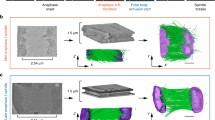Abstract
A key step for analysing the mechanochemistry of mitosis would be the isolation of a functional spindle capable of anaphase chromosome movement in vitro. Although Mazia and Dan first isolated spindles in 19521, with one or two possible exceptions2–4, isolated spindles are non-functional (reviewed in ref. 5). An alternative approach has used permeabilized cells to study anaphase chromosome movement6–10, but these preparations are biochemically and morphologically complex, and hence difficult to analyse. We describe here a simple procedure for isolating diatom spindles which are capable of anaphase spindle elongation in vitro. With addition of ATP, the two half-spindles slide completely apart, with concomitant decrease in the zone of overlap. Electron microscopy reveals decreased numbers of microtubules throughout the spindle after ATP addition and confirms the complete absence of structures beyond the spindle poles. These results are inconsistent with theoretical models of mitosis which suggest that spindle poles are pushed apart by microtubule growth11, are pulled apart by external forces applied to the poles12–15, or are released from tension generated during spindle formation16. The results are consitent with models that postulate mechanical interactions in the zone of microtubule overlap as a factor in spindle elongation17,18.
Similar content being viewed by others
References
Mazia, D. & Dan, K. Proc. natn. Acad. Sci. U.S.A. 38, 826–838 (1952).
Sakai, H., Hiramoto, Y. & Kuriyama, R. Devl Growth Differentiation 17, 265–274 (1975).
Sakai, H. et al. Devl Growth Differentiation 18, 211–219 (1976).
Goode, D. & Roth, L. E. Expl Cell Res. 58, 343–352 (1969).
Zimmerman, A. M. & Forer, A. in Mitosis/ Cytokinesis (eds Zimmerman, A. M. & Forer, A.) 327–336 (Academic, New York, 1981).
Hoffman-Berling, H. Biochim. biophys. Acta 15, 226–236 (1954).
Cande, W. Z., Snyder, J. A., Smith, D., Summers, K. & Mclntosh, J. R. Proc. natn. Acad. Sci. U.S.A. 71, 1559–1563 (1974).
Cande, W. Z. & Wolniak, S. M. J. Cell Biol. 79, 573–580 (1978).
Cande, W. Z., McDonald, K. & Meeusen, R. L. J. Cell Biol. 88, 618–629 (1981).
Cande, W. Z. Cell 28, 15–22 (1982).
Inoué, S. in Primitive Motile Systems in Cell Biology (eds Alien, R. D. & Kamiya, N.) 549–598 (Academic, New York, 1964).
Aist, J. R. & Berns, M. W. J. Cell Biol. 91, 446–458 (1981).
Bajer, A. S. J. Cell Biol. 93, 33–49 (1982).
King, S. M., Hyams, J. S. & Luba, A. J. Cell Biol. 94, 341–349 (1982).
Kronebusch, P. J. & Borisy, G. G. in Biological Functions of Microtubules and Related Structures (eds Sakai, H., Mohri, H. & Borisy, G. G.) 233–245 (Academic, New York,1982).
Snyder, J. A., Golub, R. J. & Berg, S. P. Eur. J. cell. Biol. 35, 62–69 (1984).
McIntosh, J. R., Hepler, P. K. & Van Wie, D. G. Nature 224, 659–663 (1969).
Margolis, R. L., Wilson, L. & Kiefer, B. I. Nature 272, 450–452 (1978).
Pickett-Heaps, J. D. & Tippit, D. H. Cell 14, 455–467 (1978).
McDonald, K. L., Pickett-Heaps, J. D., Mclntosh, J. R. & Tippit, D. H. J. Cell Biol. 74, 377–388 (1977).
McDonald, K. L., Edwards, M. K. & McIntosh, J. R. J. Cell Biol. 83, 443–461 (1979).
Pickett-Heaps, J. D., Tippit, D. H. & Leslie, R. Eur. J. Cell Biol. 21, 1–11 (1980).
Euteneuer, U. & McIntosh, J. R. J. Cell Biol. 87, 509–515 (1980).
Telzer, B. R. & Haimo, L. T. J. Cell Biol. 89, 373–378 (1981).
Soranno, T. & Pickett-Heaps, J. D. Eur. J. Cell Biol. 26, 234–243 (1982).
Leslie, R. J. & Pickett-Heaps, J. D. Cell 36, 717–727 (1984).
Inoué, S. J. Cell Biol. 91(2) 131s–147s (1981).
Pickett-Heaps, J. D., Tippit, D. H. & Porter, K. R. Cell 29, 729–744 (1982).
Leslie, R. J. & Pickett-Heaps, J. D. J. Cell Biol. 96, 548–561 (1983).
Guillard, R. R. L. in Culture of Marine Invertebrate Animals (eds Smith, W. & Chanley, H.) 21–88 (Academic, New York,1975).
Cande, W. Z., Tooth, P. J. & Kendrick-Jones, J. J. Cell Biol. 97, 1062–1071 (1983).
Author information
Authors and Affiliations
Rights and permissions
About this article
Cite this article
Cande, W., McDonald, K. In vitro reactivation of anaphase spindle elongation using isolated diatom spindles. Nature 316, 168–170 (1985). https://doi.org/10.1038/316168a0
Received:
Accepted:
Issue Date:
DOI: https://doi.org/10.1038/316168a0
- Springer Nature Limited
This article is cited by
-
Pivoting of microtubules driven by minus-end-directed motors leads to spindle assembly
BMC Biology (2019)
-
Mitotic spindle: kinetochore fibers hold on tight to interpolar bundles
European Biophysics Journal (2018)
-
Role of microtubule organization in centrosome migration and mitotic spindle formation in PtK1 cells
Protoplasma (1993)
-
Chromosomal passengers: Toward an integrated view of mitosis
Chromosoma (1991)
-
Ultrastructural basis of mitosis in the fungusNectria haematococca (sexual stage ofFusarium solani)
Protoplasma (1991)





